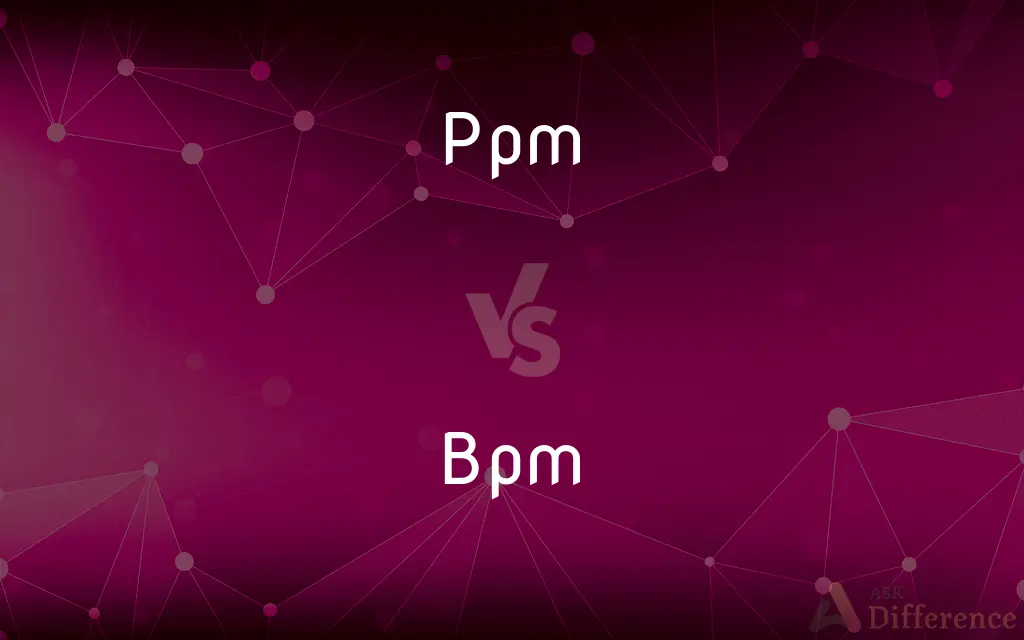Ppm vs. Bpm — What's the Difference?
By Fiza Rafique & Maham Liaqat — Updated on April 15, 2024
PPM (parts per million) measures concentration of one substance in a million parts of another, used for air and water quality, while BPM (beats per minute) denotes the number of beats in one minute, commonly used in music and heart rate monitoring.

Difference Between Ppm and Bpm
Table of Contents
ADVERTISEMENT
Key Differences
PPM, or parts per million, is a unit of measurement used to describe the concentration of one substance within a larger mixture, particularly in scenarios like pollution levels in air or water. In contrast, BPM, or beats per minute, is a metric commonly used to measure tempo in music or the frequency of an individual's heartbeat.
While PPM quantifies small amounts of a substance in large volumes—making it essential for environmental monitoring and chemical analysis—BPM quantifies the pace of music or the rate of heartbeats, serving key roles in both health assessment and musical composition.
The application of PPM is often found in scientific and industrial contexts, such as assessing the safety of drinking water or air quality. BPM, however, is widely used in healthcare for monitoring cardiovascular health and by musicians and DJs to match tempos of different tracks.
PPM involves a ratio that can also be expressed in other similar measurements like parts per billion (PPB) for even finer concentrations. Conversely, BPM is a straightforward count per minute and is universally applicable in any scenario that measures events occurring over time.
PPM measurements can influence decisions in public health and safety, environmental policies, and engineering. BPM measurements influence decisions in music production, fitness monitoring, and medical diagnostics.
ADVERTISEMENT
Comparison Chart
Definition
Measurement of concentration in one million parts of a whole
Measurement of beats occurring in one minute
Used In
Environmental science, chemistry, pollution control
Music, health monitoring, exercise physiology
Measurement Focus
Substance concentration
Event frequency (heartbeats, musical beats)
Typical Units
Particles, molecules per million parts
Beats per minute
Importance
Indicates safety levels, environmental quality
Indicates health status, musical tempo
Compare with Definitions
Ppm
Used to measure trace amounts in air, water, soil.
Air quality reports often list carbon monoxide levels in ppm.
Bpm
Commonly used in music to set and maintain tempo.
DJs adjust BPM to synchronize tracks during mixing.
Ppm
Useful in environmental and chemical analysis.
The lab uses ppm to measure various pollutant levels in industrial waste.
Bpm
Used in health for measuring heart rate.
During his workout, his heart rate reached 150 bpm.
Ppm
Parts per million, a unit measuring concentration of substances.
The concentration of lead in the water was found to be 5 ppm.
Bpm
Guides medical treatments and fitness plans.
Cardiac patients are advised to keep their resting BPM within a specific range.
Ppm
Indicates how many units of substance per million units of total.
The pesticide levels in the produce were under 2 ppm.
Bpm
Important for athletes and trainers to monitor exercise intensity.
Her target heart rate zone is 130-140 bpm for optimal fat burning.
Ppm
Critical for compliance with health and safety standards.
The factory must maintain sulfur dioxide emissions below 100 ppm.
Bpm
Beats per minute, a unit measuring frequency of beats.
The song has a fast tempo, at 120 bpm.
Ppm
(initialism) common Parts per million. (10000 ppm = 1%)
Bpm
(music) beat per minute
Ppm
(initialism) page(s) per minute
Bpm
The pace of music measured by the number of beats occurring in 60 seconds
Common Curiosities
How can BPM affect physical health?
BPM can indicate cardiovascular health and is important for determining appropriate exercise intensity.
What does PPM stand for?
PPM stands for parts per million, a unit used to measure the concentration of substances.
What does BPM measure in music?
In music, BPM measures the tempo of a song, indicating how many beats occur in one minute.
What is the difference between PPM and percentage?
PPM measures parts per million, suitable for very small concentrations, while percentage is parts per hundred.
Why is PPM important in environmental science?
PPM is crucial for determining the concentrations of pollutants in the environment, affecting regulations and health guidelines.
How do you convert PPM to PPB?
To convert PPM to parts per billion (PPB), multiply the PPM value by 1,000.
How is PPM used in water treatment?
PPM is used in water treatment to measure contaminants and ensure water safety.
What role does PPM play in public health?
Monitoring substances like lead or pesticides in PPM can help protect public health by ensuring safe levels.
Can BPM apply to things other than music or heart rate?
Yes, BPM can apply to any rhythmic events occurring within a minute, like machine cycles or strokes.
Can BPM be too high?
Yes, an excessively high BPM during rest can indicate health problems like arrhythmia.
How do musicians use BPM?
Musicians use BPM to choose the pace of music, crucial for setting the song’s mood and synchronizing with other tracks.
What common devices measure BPM?
Devices like smartwatches and heart rate monitors commonly measure BPM to track fitness and health.
What are normal BPM values for adults?
Normal resting heart rate for adults ranges from 60 to 100 BPM.
How precise is PPM in measurements?
PPM is highly precise for measuring very small concentrations in large quantities.
Is a higher BPM better when exercising?
It depends on fitness goals; higher BPM is typically targeted for higher intensity workouts.
Share Your Discovery

Previous Comparison
Laurasia vs. Gondwana
Next Comparison
Aperient vs. LaxativeAuthor Spotlight
Written by
Fiza RafiqueFiza Rafique is a skilled content writer at AskDifference.com, where she meticulously refines and enhances written pieces. Drawing from her vast editorial expertise, Fiza ensures clarity, accuracy, and precision in every article. Passionate about language, she continually seeks to elevate the quality of content for readers worldwide.
Co-written by
Maham Liaqat















































